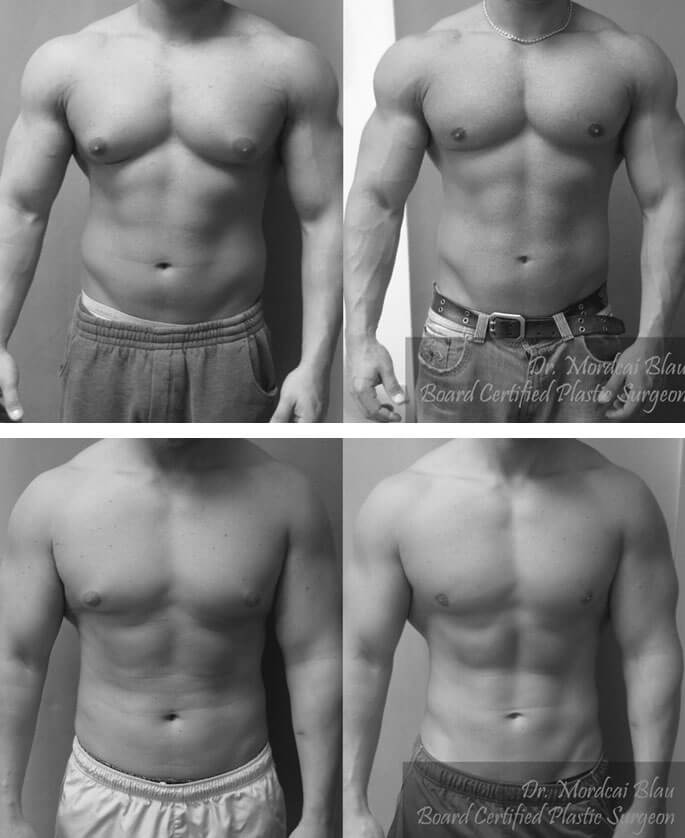Mordcai Blau, MD – The Go-To Man
Plastic Surgery Products
Issue: June 2006
The Go-To Man
by Rich Smith
Mordcai Blau, MD, PC, offers hope for males with gynecomastia
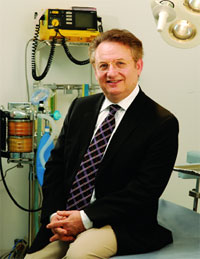 Mordcai Blau, MD, PC, did not set out to become a preeminent performer of gynecomastia surgery for men in the United States, but it certainly has turned out that way. Last year alone, Blau performed about 175 such procedures, far more than almost all other surgeons.
Mordcai Blau, MD, PC, did not set out to become a preeminent performer of gynecomastia surgery for men in the United States, but it certainly has turned out that way. Last year alone, Blau performed about 175 such procedures, far more than almost all other surgeons.
“Gynecomastia—a condition in which the male develops enlarged, feminine-appearing breasts—is a surprisingly common condition,” says Blau, who practices in White Plains, NY. He estimates that it is a problem for three out of every 10 American men. “Ideally, a man’s chest should be flat, not round. Women generally view the flat-chested man as more masculine, attractive, and sexy.”
It has been Blau’s experience that many men who suffer from oversized or flabby breasts typically try to conceal them by wrapping layers of tape tautly around their upper torso. He says that others, in desperation, will wear a bra—the most humiliating solution for any male who takes pride in his machismo.
“As a result of their gynecomastia, some males feel so embarrassed that they withdraw from social contact and lapse into deep bouts of self-pity,” Blau reports. “Only when the psychological pressure becomes too much to bear do many of these men seek the help of a plastic surgeon.” In 2005, some 18,000 men across the United States decided to throw away their bras and opt for a surgical remedy.
Avoiding Deformity
Many plastic surgeons prefer to treat gynecomastia with liposuction. Blau, however, uses liposuction as an adjunctive, not a primary, intervention. “In two thirds of the gynecomastia cases, liposuction alone cannot correct this problem,” he says. “Only comprehensive excision of the gynecomastia tissue can bring about the desired effects.”
PRACTICE PROFILE
Name: Mordcai Blau, MD, PC
Location: White Plains, NY
Specialty: Plastic surgery
Years in practice: 26
Number of patients per day: 20
Number of new patients per year: 1100
Days worked per week: 5
Days surgery performed per week: 5
Number of employees in practice: 10
Office square footage: 2,200
Blau says the best candidates—those who can expect to see the most stellar results from surgery—are those with the least amount of excess skin and adipose tissue above their pectoral muscles. “The less adipose and excess skin tissue the person has, the more gynecomastia tissue can be removed without leaving a depression or deformity,” Blau says. “In those patients, after surgery, the skin will drape directly on a developed pectoral muscle, and the chest will look more masculine and attractive.”
If too little tissue is excised, there is a 10% or greater chance that gynecomastia will recur. However, Blau says the chance of recurrence can be decreased to less than 5% if at least 90% of real breast tissue is removed. “Knowing exactly how much excision to make without causing a depression and deformity isn’t easy, but it’s key to the success of the whole procedure,” Blau explains.
Typically, Blau likes to begin a gynecomastia surgery with a periareolar incision, because this particular site will leave an essentially undetectable postoperative scar. To further ensure an unnoticeable scar, he limits the incision length to between 1 and 1½ inches.
Blau tells patients to halt their use of all dietary supplements for 2 weeks prior to surgery and to stay off them for 2 weeks following surgery. “If not stopped prior to surgery, dietary supplements can cause complications,” he explains.
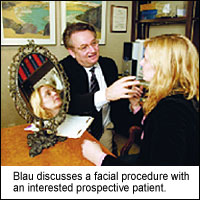 “Some supplements increase the risk of excessive bleeding during surgery. If that occurs, it will make it more likely that I can’t completely excise all of the gynecomastia tissue. Then, after the surgery, supplements—because of the way they thin the blood—may also cause hematomas or seromas.”
“Some supplements increase the risk of excessive bleeding during surgery. If that occurs, it will make it more likely that I can’t completely excise all of the gynecomastia tissue. Then, after the surgery, supplements—because of the way they thin the blood—may also cause hematomas or seromas.”
Bodybuilders Are Hardest Hit
Gynecomastia turns out to be more of a problem for bodybuilders than for couch potatoes. Accordingly, a sizable share of Blau’s patients are professional and serious amateur weight lifters.
“When bodybuilders—as opposed to sedentary, overweight persons—develop gynecomastia, it’s because they have real gland tissue involved,” he says.
Some bodybuilders try to turbocharge their ability to build muscle by taking anabolic steroids. Steroids often deliver on their promise of quick and relatively easy muscle development, but they usually do so at a terrible price. Among the side effects is estrogen production, which can stimulate the growth of female-looking breasts.
Says Blau, “How much estrogen is produced depends on the particular type of ste roid substance used and how often it’s being taken. And then there are some types of ste roids that simply convert to estrogen. Either way, you’ve got these very muscular men with abnormally high concentrations of fe male hormone in their bodies. Studies have shown that high-dose, high-frequency steroid usage is directly proportional to the probable development of gynecomastia.”
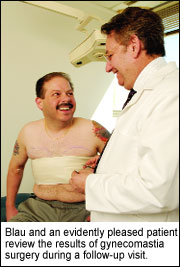 Fortunately for bodybuilders (steroid takers or not), they are usually the ones best helped by gynecomastia surgery because they have such well-developed pectoral muscles. Not so fortunate are non-bodybuilders, unless they commit to a regimen of physical training to develop their pectorals. But Blau contends that even sedentary men will look better after gynecomastia surgery. “Nonathletic types will have a chest that is a lot more natural, the way an average man should appear.”
Fortunately for bodybuilders (steroid takers or not), they are usually the ones best helped by gynecomastia surgery because they have such well-developed pectoral muscles. Not so fortunate are non-bodybuilders, unless they commit to a regimen of physical training to develop their pectorals. But Blau contends that even sedentary men will look better after gynecomastia surgery. “Nonathletic types will have a chest that is a lot more natural, the way an average man should appear.”
Blau himself is not a bodybuilder, but that hasn’t deterred world-class champions in that sport—whose ranks include women—from seeking his help.
“Several of the women bodybuilders I’ve worked on have gone on to claim important titles, including one woman who won the 2005 US and world championships in her division,” Blau says, clarifying that supermuscular females don’t come to him for gynecomastia surgeries, but for other procedures—mainly breast augmentation and mid- to lower-body liposuction.
“Another class of women I treat are extreme fitness enthusiasts. They are not as buffed and cut as the female bodybuilders; nonetheless, they have exquisitely firm and toned bodies. Like the bodybuilders, they also come primarily for breast enhancement and liposuction. No matter how hard they work at it, these athletes still have layers of fat that they can’t get rid of in their thighs and along the belt line without a surgical assist.”
The Word Gets Around
Blau’s involvement with gynecomastia dates back to the early days of his practice. At the time, around 1980, he was teaching at nearby Westchester Medical Center. One day, Blau was approached by a medical student who wanted the shape of his breasts cosmetically modified.
“This student was a bodybuilder, and he needed a gynecomastia procedure to tighten up his pectoral area to give him more of that muscular but flattened, ‘cut’ look that bodybuilders strive for. I wasn’t all that enthusiastic about it, but I said ‘sure’ and agreed to do it. The results were very good, and the student was very pleased.”
He was so pleased that soon he began sending his bodybuilder friends to Blau for the same procedure. However, these friends were not casual exercisers, men who hung around at the corner health club and pumped iron for the heck of it. These were serious bodybuilders—competition champions.
“A couple of them were winners of US events; one was a winner from Canada.” Before Blau could say Incredible-Hulk-versus-Conan-the-Barbarian, his waiting room began to look like the lobby of Gold’s Gym in Venice, Calif. “It was mostly professional bodybuilders who were coming to my office, and they were from all over the continent,” he recounts.
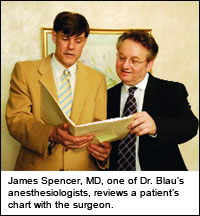 Gradually, however, word spread from the bodybuilders to their scrawnier male relatives and friends, who also suffered from enlarged male breasts. In time, the average Joes seeking Blau’s help surpassed the number of bodybuilders.
Gradually, however, word spread from the bodybuilders to their scrawnier male relatives and friends, who also suffered from enlarged male breasts. In time, the average Joes seeking Blau’s help surpassed the number of bodybuilders.
“Ordinary men heard about this—men who had just lost significant weight and men who were genetically predisposed toward the condition—and they started coming too,” he says.
Coming to America
Blau first learned about gynecomastia while attending Tel Aviv Medical School in his native Israel. Blau entered that academy in 1969, and 4 years later he completed his training in a program that included a year of plastic surgery instruction.
Immediately afterward, Blau was conscripted into the Israeli army. He was the only physician for a fairly sizable contingent of soldiers—about 700 in all.
In peacetime, that would have been a burdensome enough responsibility. But, alas, Blau’s Sinai Peninsula-based unit was in the thick of the fighting that broke out when Egypt and Syria attacked Israel during the Jewish high holy day of Yom Kippur in 1973.
The war lasted a relatively short time. How ever, for weeks after the hostilities ceased, Blau performed minor to moderately complicated surgeries on soldiers in his unit and several others who had been wounded in battle. It was dispiriting work on the one hand, but beneficial for Blau on the other. The volume of cases he handled allowed him to become very proficient at reconstructive procedures.
Blau completed his obligations to the military in 1974, and shortly thereafter he immigrated to the United States. “I wanted to be trained in cosmetic plastic surgery, but, at the time, that was a speciality almost unheard of in Israel. The place for that was the United States,” he says.
“My idea was to come to America for training, return to Israel, and start a cosmetic practice there. But it just didn’t work out that way. I fell in love with the United States and decided to stay here.”
Once on American soil, he was welcomed to Albert Einstein Medical Center in New York City, where he spent the next 6 years undergoing training in general and plastic surgery. During his time there, Blau became chief resident of the plastic surgery department and worked as an anatomy lab instructor.
Accredited Facility
In 1980, having wrapped up his training at Albert Einstein, Blau moved to White Plains, in Westchester County just north of New York City, where he opened a private practice. “My wife’s sister lived near White Plains, so we would often drive out for visits,” he remembers. “We really liked it—it was a nice area, very upscale, and it was close to New York City. I thought it would be a perfect place to have an office.”
Still a relative newcomer to the Empire State, Blau knew he was taking a huge risk by striking off as a solo practitioner—especially in a market already saturated with plastic surgeons. Indeed, there were times during the first months that Blau worried that his practice might go under. That it did not was a testament to Blau’s determination to succeed.
“I developed a rotation of about five hospitals in this area where I worked the emergency rooms, performed lots of hand reconstructions, and treated trauma and burn cases,” he says. “The patients I worked on liked what I did, and so they began referring family and friends to my office. After about 6 months, people started asking me about cosmetic procedures. Then, every year afterward, the cosmetic cases grew, until now they are the vast majority of my work.”
Two years after launching his practice, Blau moved into the facility he occupies today. “It’s located a block away from White Plains Hospital in a freestanding medical office building,” he says.
The office has four treatment rooms (two of them are equipped with lasers for ablative and chemical-peeling work); two consultation rooms; a large secretarial room; a similarly large reception area; and an in-office, Joint Commission on Accreditation of Healthcare Organizations-accredited surgery suite.
“I do most of my procedures right here,” he says. “I’ve got a couple of anesthesiologists who come in, and I’ve got an operating-room nursing team in place. Only on rare occasions do I use the hospital’s surgery center.”
At one point, Blau contemplated adding a medical spa, but he ultimately decided against it. “It just didn’t seem like a good fit for my particular practice. Besides, I’m busy enough as it is,” he explains.
Blau estimates he performs about 500 surgical procedures of all types during the span of a typical year. The vast majority of them involve body work and sculpting. About 20% are facial procedures.
The Artist in Him
Blau was motivated to seek a career in plastic surgery in part because of his love of art—not just as one who appreciates well-crafted paintings but as one who creates them.
“I started oil painting when I was young,” he says. “My mother was an artist, and she got me interested in it. In medical school, I learned anatomy in part by painting it.”
In addition to oil paints, Blau also dabbles in watercolors and charcoal as well as stone and clay. His favorite subject matter is the human body. Blau characterizes his style as eclectic, but it is plainly influenced by early Picasso and Gauguin.
“I like the impressionists most of all,” he says. “They took everyday subjects and revealed the hidden beauty within them. Very gutsy in the time in which they lived and worked.”
Blau not long ago was honored with an award in artistic excellence from the Ruben Dario Cultural Institute, and his artworks have been exhibited at galleries in New York City, in San Francisco, even in Germany. Many of those pieces now hang throughout his office and his home—the best of them, that is; everything else is stored in the basement, which is brimming with his art. “I never get rid of any of my older works. I keep everything,” he says.
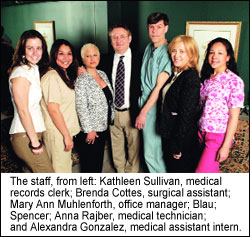 And yet, it is plastic surgery for which Blau—a diplomate of the American Society of Plastic and Reconstructive Surgeons—is most widely celebrated. For example, the Westchester County Medical Society feted him for dedicated service to patients and to the medical profession, while the Consumer’s Research Council of America tapped Blau for a spot on its America’s Top Surgeons list a few years ago.
And yet, it is plastic surgery for which Blau—a diplomate of the American Society of Plastic and Reconstructive Surgeons—is most widely celebrated. For example, the Westchester County Medical Society feted him for dedicated service to patients and to the medical profession, while the Consumer’s Research Council of America tapped Blau for a spot on its America’s Top Surgeons list a few years ago.
On top of this, Yeshiva Uni versity heralded him as a respected community leader, esteemed congregant, and outstanding community figure for his devoted and noteworthy service to the public and to Jewish people everywhere.
The loudest applause for Blau comes, of course, from his satisfied gynecomastia patients, who, if they had an organization of their own, would in all likelihood also give Blau an award of some sort. Certainly, the parents of one 16-year-old athlete would love to see Blau thus lionized, so greatly did the amiable and soft-spoken physician’s work on him bring about dramatic, positive change in the youngster’s life.
“This teenager was a gifted football player—tall, handsome, and in great physical condition—but he was extremely embarrassed by the shape of his enlarged breasts,” Blau says. “He would go to the beach and never take off his shirt. Never. He was really going through a lot of psychological suffering. Eventually, his parents became so concerned about him that they brought him in to be seen by me.
“At first, I felt he was a little too young to be thinking about a surgical solution. But his parents pleaded with me to take the case. I finally agreed because of the severe psychological trauma the youth was experiencing. We went to surgery, and it was a complete success. The teenager felt a tremendous load had been lifted from his shoulders.”
As Blau can attest, concern with breast size is no longer limited to women. The good news he offers to men with feminine-looking chests is that they can be helped. And, thanks to Blau’s long years of experience in treating gynecomastia, the help that awaits is among the finest to be found. PSP
Rich Smith is a contributing writer for Plastic Surgery Products.


